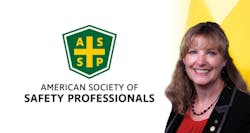ASSP President Diana Stegall: Risk, Women and the C-Suite
Diana Stegall knows about risk, not from being on the floor but from observing first-hand the costs associated with workplace injuries.
Her penchant for reducing risks and injury reduction began as a child.
“I would take a look at what my older brother and sister were doing and would say, ‘You could break a bone. That just looks too dangerous. I’m not going to do that,’ Stegall explains.
The concern for others carried into her professional career, where she began working in the insurance industry and studied risk in several different industries.
The president-elect of the American Society of Safety Professionals (ASSP) spoke with EHS Today about how she will use her experience to assist members in communicating the value of a world-class safety program.
EHS Today: Please discuss your background and how you plan to use those experiences to enhance ASSP’s mission.
Diana Stegall: I majored in chemistry around the time the Hazard Communication Standard came out. I remember very distinctly a switch where, all of a sudden, before lab studies, there’d be more specifics such as reviewing the material safety data sheets and the personal protective equipment you need to wear and why you need to wear it.
After college I got a job with United States Fidelity and Guarantee Company, which was an insurance company, and went through their insurance engineering and audit training program, where I really got to learn more about risk. Getting into the insurance end and what that helped me to do is to get exposed to a lot of different industries.
I’ve been exposed to leaders at all levels within their organization, from floor-level line workers, facilities managers and maintenance people, all the way up to the CEO. Learning the different industries and how to relate to different levels within an organization allows me to take that information and then use my experiences to help the [safety] profession as we move forward.
One of the big parts is really looking at it from a risk management perspective and understanding that there are risks in everything we do, but how do we as safety professionals start thinking about risk and not just the hazard? Saying that if there is a hazard, we need to put controls in place.
Beyond the physical controls, we’re looking at the hierarchy of controls of eliminating or substituting or administrative controls or personal protective equipment. What are some other ways we can mitigate this risk for our organization so that we can accomplish what it is we want to accomplish within our employer base? But, to do it safely and with really good risk management practices in place.
EHS Today: How can you communicate to a C-suite executive how the value of safety helps the bottom line of a company?
Stegall: One of the things I learned, and being on the insurance side, is how you really got to see how organizations that were proactively managing their risk had lower premiums, reduced turnover, reduced absenteeism and really a better public face.
For example, one of the things we as safety professionals do is really help to provide that competitive advantage to businesses in all industries. A couple of ways we do that are, one, sound safety practices, they’re socially responsible and they’re good business. They lead to increased productivity because employees aren’t going to have to worry about how they can do something safely without getting hurt. It also leads to higher employee satisfaction.
As I’ve worked with organizations, I’ve been able to help them understand that if we put these controls in place, it’s going to reduce the injuries that occur and that’s going to impact what you’re paying from a workers’ comp standpoint.
EHS Today: What efforts are being made in terms of women in the safety industry?
Stegall: We had the Women’s Workplace Safety Summit last fall, in October. That had three main tracks—personal protective equipment, women in leadership, and violence in the workplace. We’ve pitched those because those are pretty much cross-industry.
The PPE track focused on looking at and working with the manufacturers of the equipment to say, hey, making something that is for women doesn’t just mean making it leopard print or making it pink. We really need to be looking at not just sizes but also how does it fit. Women’s bodies are a little different than men’s. So, taking those things into account.
How do we get more women in the leadership roles? That starts by not just recognizing we need diversity, but we also need to be sure that people are feeling included. It’s one thing to be invited to the dance, but if you’re not being asked to dance, that’s where the inclusivity comes into play.
One thing I’ve been focusing on a little bit more is the workplace violence prevention. It is a growing risk in America and the leading cause of death for women at work. In February, ASSP published a technical report about dealing with active shooter risks.
One of the things we need to consider is that when we talk about violence in the workplace, there are signs ahead of time. It’s the bullying. It’s the harassment that occurs. It’s an environment where it’s okay to make disparaging remarks. That doesn’t help from an inclusivity standpoint. It doesn’t help from a diversity standpoint, and it can create a culture where it is acceptable to increase the violence. So, it’s not really addressing that.
Some of the things that employers can do is create a comprehensive and integrated approach that addresses mental health along with the physical wellness of their workers.
Also look at what are those policies and procedures we have in place and ask, “Are we really enforcing those? Are we helping our supervisors understand the warning signs of potential workplace violence?” One of the things that we talked about a lot in the breakout group at the women’s workplace summit was there is a lot of “it won’t happen here” mindset, which means that we’re not really opening our eyes to say, “Okay, what can happen?”
One of the things we’re doing within ASSP is we just submitted a statement to several members of the House of Representatives. There’s a bill—HR Bill 1309—that aims to prevent workplace violence in the healthcare and social service industries. In those two industries, you have people who are caring, who want to go into this industry, but their workplace violence incidence is higher than many of the others—not necessarily the fatality piece, but severe injuries on a regular basis.
EHS Today: What does it mean to you to be a woman in the field? Have there been any challenges or triumphs you have experienced?
Stegall: I would say we’ve come a long way. My first real experience with that was when I was in high school. It was during a gifted and talented program over the summer, and the chair of the chemistry department said that, well, women shouldn’t major in chemistry.
I’ve also had situations along the way where my first employer worked a lot in the construction industry, and occasionally, you’d run into the owner of the construction company and they would say, “I don’t want no skirts on my job.” Fortunately, there was support who would say, “Diana’s good at what she does. She doesn’t wear skirts to job sites.” And we would work through that. But there would be examples of that and even just how people will refer to you.
Sometimes during a meeting, even though you’re the one who’s leading the meeting, the men on the other side of the table and, unfortunately it’s not always just men, respond back even though you asked the question to the male who’s sitting beside you. So, that does still exist, but it is getting better.
At my chapter’s professional development conference in February, one of the newer members to the profession, a recent graduate who is working for a construction company, was sharing some of the challenges she is facing. She is being asked questions and asked to do things that are really outside the scope of her job and outside the scope of what someone else would be asked to do.
So, her supervisor was setting her up for failure in a big way. One part of the conversation was letting her know that not all construction companies are that way. Not all supervisors are that way and providing her some resources and encouraging her to really look at other options, because no one should be put in a situation to where you are being set up for failure in a major way for something that you are perfectly competent at. But the questions that were being asked and what she was being asked to do was impacting her confidence in being able to be a safety professional and that’s just not right.
About the Author

Stefanie Valentic
Stefanie Valentic was formerly managing editor of EHS Today, and is currently editorial director of Waste360.
